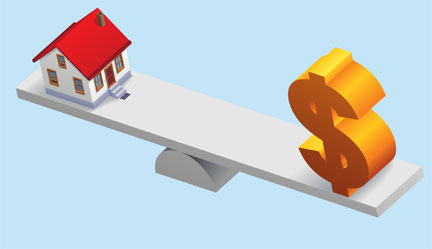
A MULTITUDE OF MORTGAGE OPTIONS

Despite what you may have read about how difficult it is to get a mortgage loan, the fact is that 60 percent of people who apply are eventually approved.
Lenders have simply gone back to basics, requiring steady employment, a low debt-to-income ratio and a good credit score. For example, your proposed monthly housing expense, including payments for taxes and insurance, shouldn’t exceed about 28 percent of your gross monthly income.
If you don’t know what your taxes and insurance will be, figure them at roughly 15 percent of your estimated mortgage payment.
Your proposed monthly housing expense, plus other recurring payments such as car loans, child support and alimony, credit cards and student loans, shouldn’t exceed about 36 percent of your gross monthly income.
Depending on your specific situation, there may be some flexibility in the 28 percent and 36 percent guidelines, which are sometimes referred to as “front-end ratios” and “back-end ratios.” If you’re able to buy a home while borrowing less than 80 percent of its value by making a large cash down payment, the qualifying ratios become less critical.
In general, however, if the ratios are right, and if you have a credit score of more than 620, you should be able get a home loan.
But there’s no question that today’s borrowers have fewer options than they did prior to 2008, when a steady pulse was just about all you had to demonstrate.
To find out more about the different sources that provide home financing, and the features and benefits of the various loan products they offer, check with your banker or mortgage lender. In the meantime, here’s a summary:
• FHA Loans. If you’ve got only minimal cash for a down payment and your credit history has a few blemishes, a federal government-backed loan is most likely your best choice. Federal Housing Administration (FHA) loans allow down payments as low as 3.5 percent along with generous credit underwriting.
• VA Loans. Veterans Administration (VA) loans require no down payment, but you must be a veteran to qualify. United States Department of Agriculture (USDA) rural loans also allow zero down, but they’re limited to areas with relatively small populations and may have income restrictions.
• Conventional Loans. If you have more than 10 or 20 percent to put down, these may be your best bet. Conventional loans are designed to be sold to Fannie Mae and Freddie Mac, the government-chartered mega-investors. The downside is, conventional underwriting rules are more strict now, and banks may impose add-on fees to loans, thereby increasing your cost. Down payments below 10 percent may be allowed, but they will require high private mortgage insurance premiums.
• Construction Loans. A construction loan is useful if you’re building a home yourself as general contractor or working with a custom builder. Most construction loans provide short-term funds designed to get you through the building stage of your project (six to 12 months) followed by a conversion into a permanent long-term loan of 30 or 15 years.
• Builder Financing. Most large- and medium-sized builders either have wholly owned mortgage subsidiaries or affiliate relationships with outside mortgage companies. Some builders also offer title insurance and settlement services. If the builder handles your financing, your loan may be included in a package that encompasses sales incentives such as upgrades and price breaks. Financing through your builder may also reduce the time needed to move from application through settlement.
